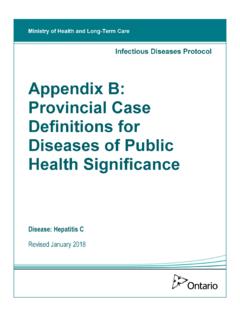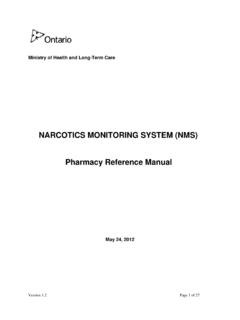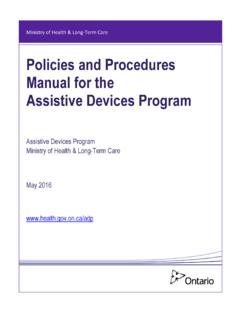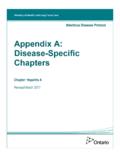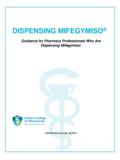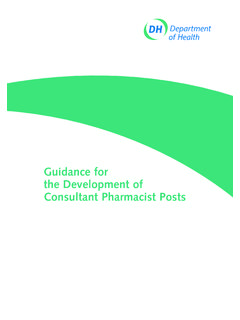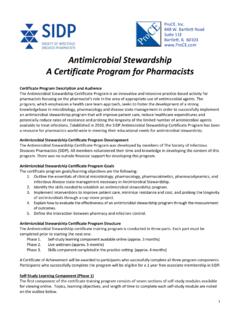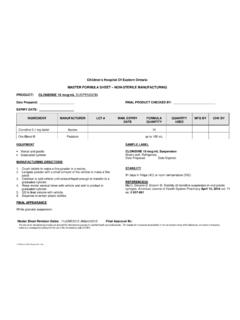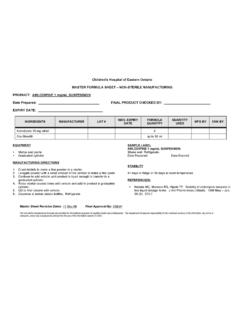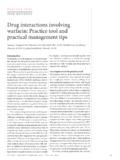Transcription of Frequently Asked Questions for Ontario Pharmacists: …
1 Ontario Public Drug Programs, Ministry of Health and Long-Term Care Frequently Asked Questions for Ontario pharmacists : Blood Glucose Test Strip Reimbursement Policy 1. Why is the ministry introducing changes to the reimbursement of Blood Glucose Test Strips (BGTS)? Research has indicated that BGTS have a limited benefit for many patients who do not take insulin to manage their diabetes. Based on best evidence, the government is introducing changes to the number of BGTS it will reimburse people with diabetes while ensuring those who need test strips to help manage diabetes, will continue to have access to them. The new changes on the reimbursement of blood glucose test strips are effective August 1, 2013, and are aligned with the Canadian Diabetes Association (CDA) to encourage proper testing practices for optimal patient outcomes.
2 A July, 2009 report from the Canadian Agency for Drugs and Technologies in Health (CADTH), stated that in practice, blood glucose test strips have a limited clinical benefit for many patients who are not on insulin. The CDA also published a commentary for healthcare providers recognizing that some limits on the number of blood glucose test strips reimbursed for patients on oral anti-diabetes medications may be reasonable. 2. How often should patients be self-monitoring their blood glucose? The ministry's BGTS reimbursement policy is in alignment with the CDA. recommendations to test according to the current medication profile. The CDA has made several recommendations about Self-Monitoring of Blood Glucose (SMBG) in their 2013 Clinical Practice Guidelines: For individuals using insulin more than once a day, SMBG should be used as an essential part of diabetes self-management [Grade A, Level 1, for type 1 diabetes; Grade C, Level 3, for type 2 diabetes] and should be undertaken at least three times per day [Grade C, Level 3] and include both pre- and postprandial measurements [Grade C, Level 3].
3 In those with type 2 diabetes on once-daily insulin in addition to oral antihyperglycemic agents, testing at least once a day at variable times is recommended [Grade D]. For individuals with type 2 diabetes not receiving insulin therapy, SMBG. recommendations should be individualized depending on type of antihyperglycemic agents, level of glycemic control and risk of hypoglycemia [Grade D]. When glycemic control is not being achieved, SMBG should be instituted [Grade B, Level 2] and should include periodic pre- and postprandial 1. measurements and training of healthcare providers and patients on methods to modify lifestyle and medications in response to SMBG values [Grade B, Level 2]. If achieving glycemic targets or receiving medications not associated with hypoglycemia, infrequent SMBG is appropriate [Grade D].
4 For a complete version of the 2013 Clinical Practice Guidelines: 3. When will changes in reimbursement of BGTS be in effect? The changes for BGTS reimbursement are effective on or after August 1, 2013 and will be applied on the first claim for test strips after this date. 4. How many diabetes test strips are ODB recipients eligible to receive under the ODB Program? As of August 1, 2013, the Health Network System (HNS) will track and determine appropriate levels of reimbursement of BGTS based on the current diabetes therapy used by eligible ODB recipients. When a claim is submitted for BGTS for eligible ODB recipients, the HNS will automatically review the anti-diabetes medications claims within the previous six months to identify claims for insulin products and other anti-diabetes medications.
5 The HNS will then apply a maximum number of self-monitoring BGTS that may be reimbursed for the recipient in the following 365 days, based on both online and paper claims as follows: Diabetes Treatment History Number of BGTS allowed within a 365-day period Patients managing diabetes with insulin 3,000. Patients managing diabetes with anti-diabetes 400. medication with high risk of causing hypoglycemia*. Patients managing diabetes using anti-diabetes 200. medication with low risk of causing hypoglycemia Patients managing diabetes through diet/lifestyle 200. therapy only (no insulin or anti-diabetes medications). (*low blood sugar). For additional information regarding treatment classes, please refer to question 7 below. Recipients will be allotted the indicated number of test strips for use over the course of a 365-day period.
6 The test strip allotment will apply to both online and paper claims. 2. When submitting a claim for insulin or anti-diabetes medication along with a claim for BGTS, pharmacists should submit all anti-diabetes medications prior to entering the BGTS claim. This ensures that the most current drug profile is included in the historical treatment review and patients are allocated the proper number of test strips. Similarly, all related paper claims should be submitted for processing as soon as possible. When a claim is submitted, the HNS will look back over the prior 365 days, and will calculate whether the recipient has met their allotted maximum during that time. If the recipient has not reached their maximum number of allotted test strips over the previous 365 days, they will be eligible to receive test strips up to the maximum amount.
7 5. When does the new policy for reimbursement start for each patient? The application of a maximum number of test strips provided to an individual in a 365- day period begins when a pharmacist submits the first claim for BGTS for the patient on or after August 1, 2013. 6. How should simultaneous claims for test strips and insulin/anti- diabetes medications be processed? When submitting a claim for insulin or anti-diabetes medication along with a claim for BGTS, pharmacists should submit all anti-diabetes medications prior to entering the test strip claim. This ensures that the most current drug profile is included in the historical treatment review and patients are allocated the proper number of test strips. All related paper claims should be submitted for processing as soon as possible.
8 The test strip allotment will apply to both online and paper claims. 7. What insulin or anti-diabetes medications will the HNS use to determine treatment categories for ODB recipients? The HNS system will determine the treatment category for an ODB recipient based upon claims for insulin products or other anti-diabetes medications available on the ODB. Formulary. Treatment Class Medication Name or Class Patients managing diabetes with anti-diabetes Sulfonylureas ( medication with HIGH risk of causing glyburide). hypoglycemia Meglitinides ( nateglinide). Patients managing diabetes using anti-diabetes Metformin medication with LOW risk of causing Acarbose hypoglycemia Thiazolidinediones ( pioglitazone). DPP-4 inhibitors ( saxagliptin). 3. GLP-1 agonists ( exenatide). 8. What should I do if an ODB recipient has received insulin or anti- diabetes medications that were not reimbursed under the ODB.
9 Program? The intervention code NF Override Quantity Appropriate may be used for patients who require more than 200 or 400 test strips in a given year because they had claims for insulin and/or anti-diabetes medications at high risk for hypoglycemia in the recent six months that were not reimbursed under the ODB program. The identified anti-diabetes medications that were reimbursed by private drug insurance plan or paid by the patient must be documented and readily available for audit purposes. 9. How would I know how many strips a patient is entitled? pharmacists can determine the overall annual allotment for test strips that patients are entitled to by assessing the patient's medications in the past six months and the number of strips already reimbursed in the past 365 days at any point in time.
10 In order for patients to track the remaining number of strips available for reimbursement, patients should be encouraged to have their prescriptions filled at one pharmacy to ensure that they have a complete history of all the medications and test strips that they have received in the past. 4. 10. What happens when an ODB recipient reaches their annual allotment of test strips? If the maximum number of test strips is exceeded in a 365-day period for a given patient, a response code is provided to the pharmacist indicating that the recipient has reached their allotment and the claim is rejected. If the claim can be accepted by reducing the quantity of strips dispensed, a response code and message line will be returned to the pharmacy (OC Quantity Reduction Required) to advise the pharmacist of the allowable number of test strips for the recipient before they reach their limit.
